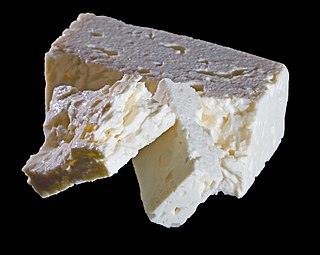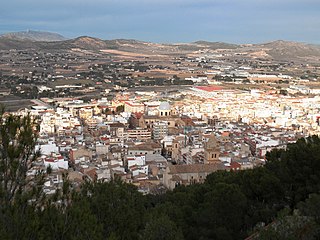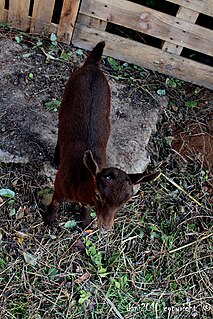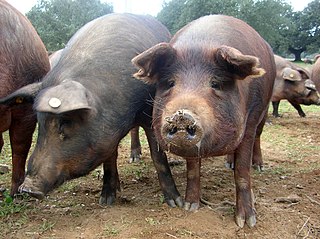Related Research Articles

Manchego is a cheese made in the La Mancha region of Spain from the milk of sheep of the Manchega breed. It is aged between 60 days and 2 years.

Feta is a Greek brined curd white cheese made from sheep's milk or from a mixture of sheep and goat's milk. It is a soft, brined white cheese with small or no holes, a compact touch, few cuts, and no skin. It is formed into large blocks, and aged in brine. Its flavor is tangy and salty, ranging from mild to sharp. It is crumbly and has a slightly grainy texture. Feta is used as a table cheese, in salads such as Greek salad, and in pastries, notably the phyllo-based Greek dishes spanakopita and tyropita. It is often served with olive oil or olives, and sprinkled with aromatic herbs such as oregano. It can also be served cooked, as part of a sandwich, in omelettes, and many other dishes.

The Nigerian Dwarf is an American breed of dwarf goat. Like the American Pygmy Goat, it derives from the West African Dwarf group of breeds of West Africa.

Yecla is a town and municipality in eastern Spain, in the extreme north of the autonomous community of Murcia, located 96 km from the capital of the region, Murcia.

The Bagot goat is a breed of goat which for several hundred years has lived semi-wild at Blithfield Hall, Staffordshire, England.

The Ratonero Bodeguero Andaluz is a Spanish breed of dog of the terrier type. Its name reflects its main occupation: hunting rats and mice hidden between barrels in the wineries of Andalusia in Spain. It was recognised as an indigenous Spanish breed in 2000 by the Spanish Ministry of Agriculture and by the Spanish Kennel Club, the Real Sociedad Canina de España.

Goat milk is the milk of domestic goats.

The Livestock Conservancy, formerly known as the American Livestock Breeds Conservancy (ALBC) and prior to that, the American Minor Breeds Conservancy, is a nonprofit organization focused on preserving and promoting rare breeds, also known as "heritage breeds" of livestock. Founded in 1977, through the efforts of livestock breed enthusiasts concerned about the disappearance of many of the US's heritage livestock breeds, the Conservancy was the pioneer livestock preservation organization in the United States, and remains a leading organization in that field. It has initiated programs that have saved multiple breeds from extinction, and works closely with similar organizations in other countries, including Rare Breeds Canada. With 3,000 members, a staff of nine and a 19-member board of directors, the organization has an operating budget of almost half a million dollars.

The Golden Guernsey is a rare breed of dairy goat from Guernsey in the Channel Islands, where it has been known for more than two hundred years.

The domestic goat or simply goat is a subspecies of C. aegagrus domesticated from the wild goat of Southwest Asia and Eastern Europe. The goat is a member of the animal family Bovidae and the subfamily Caprinae, meaning it is closely related to the sheep. There are over 300 distinct breeds of goat. It is one of the oldest domesticated species of animal, according to archaeological evidence that its earliest domestication occurred in Iran at 10,000 calibrated calendar years ago.

The Alpine is a medium to large sized breed of domestic goat known for its very good milking ability. They have no set colours or markings. They have horns, a straight profile and erect ears.

The Murciano-Granadina is a Spanish breed of dairy goat. It was created in 1975 when two existing breeds, the mahogany-coloured Murciana of Murcia and the black Granadina of Granada, began to be hybridised as a result of the official recognition of a single herdbook including both breeds. It is the most important dairy goat breed of Spain, with more than 500,000 milking females. It originated in the semi arid areas in south eastern Spain, including parts of Murcia, Almería, Granada and Alicante. They were bred for two main traits, milk production and its ability to continue this production in dry and nutrient poor regions. They have been introduced into several areas in Latin America as well as northern Africa.

Extremadura, Spain is known for its different ways of preparing the Iberian pork and mutton. The main characteristics of the traditional Extremaduran cuisine were its simplicity, its lack of clutter and its low cost. It is also a cuisine reflecting a generous spirit, for many of its preparations used to be cooked in large pots to share with visitors, friends, and neighbors. The resulting dishes are eaten with local bread.

Cheeses in Mexico have a history that begins with the Spanish conquest, as dairy products were unknown in pre-Columbian Mesoamerica. The Spanish brought dairy animals, such as cattle, sheep, and goats, as well as cheesemaking techniques. Over the colonial period, cheesemaking was modified to suit the mixed European and indigenous tastes of the inhabitants of New Spain, varying by region. This blending and variations have given rise to a number of varieties of Mexican cheeses. These are most popular in the country, although European cheeses are made, as well. Almost all cheese in Mexico is made with cows’ milk, with some made from goats’ milk. More recently, efforts have been made to promote sheep's milk cheeses. Most cheeses are made with raw (unpasteurized) milk. Cheeses are made in the home, on small farms or ranches, and by major dairy product firms. Between 20 and 40 different varieties of cheese are made in Mexico, depending on how one classifies them. Some, such as Oaxaca and panela, are made all over Mexico, but many are regional cheeses known only in certain sections on the country. Some of the least common are in danger of extinction.

American Lamancha, or more commonly, simply Lamancha or LaMancha, is a formally recognized breed of dairy goat, first bred in California by Mrs. Eula Fay Frey about 1927. Later she moved the herd to Glide, Oregon for further development. The Lamancha goat is a member of the Capra genus, specifically Capra aegagrus hircus, like all domestic goats.
Murciana, also called Murcian, Murcien, Murciene and Royal Murciana is a dual-purpose breed of goat originally bred in the Murcia province along the Mediterranean coast of southeastern Spain. The main milk-producing goat breed in Spain is a cross between the Murciana and the Granadina goat known as Murciano-granadina goat. Only the latter is officially recognized by the Spanish government, so Murciana goats are considered a variety of such breed.

Goat farming involves the raising and breeding of domestic goats as a branch of animal husbandry. People farm goats principally for their meat, milk, fibre and skins.

Payoya is a Spanish breed of goat from the Sierra de Cádiz. It is named after the village of Villaluenga del Rosario, whose inhabitants are known as payoyos. This breed is officially considered to be endangered by the Government of Spain. It is a dairy breed, famous for the payoyo cheese made from its milk since 1997.
References
- 1 2 3 4 Cortés Espinosa, Silvia (2010). "Creación del banco de germoplasma de la cabra granadina [Germplasm bank of the Granadina goat population]" (PDF). Abstracts for the 10th International Conference on Goats, Brazil. Universidad de Córdoba. Retrieved 2 October 2019.
- ↑ Tejerina Ampudia, Fernando. "Raza caprina MURCIANO-GRANADINA". Ministerio de Agricultura, Pesca y Alimentación. Retrieved 2 October 2019.